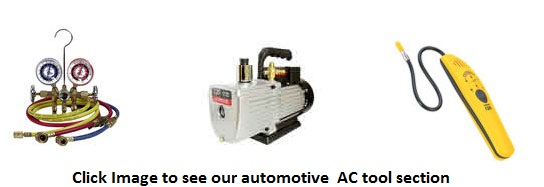Basic Car AC Gauge Set Hook-Up
April 24, 2011 2:00 pm Air Conditioning© DenLorsTools.com Summary: Tips and basic instructions from an ASE master auto technician on how to hook up AC gauges to a car’s 134A air conditioning system.
A common question has been; What year did the car manufacturers start using 134A? The answer is 1995. While there are new refrigerants on the horizon for automotive use, the overwhelming majority of car AC systems today use 134A refrigerant. R12 refrigerant was used in cars built in 1994 or prior. Although in the mid nineties the production of R12 was halted, many repair shops recycled R12 for several years. R12
systems, were usually converted to the more accessible and less expensive 134A anytime a system had to be repaired and it was more feasible. The 134A systems are easy to spot because of the much different service port connectors. 134A uses a larger, non-threaded connector. It’s called a quick connect. The low and high side service ports on cars are somewhat fool-proof because of the different size connectors. The low side is smaller than the high side making it impossible to hook them up incorrectly. Color coding on the AC Manifold Gauge Set hoses also makes identifying them easier. Blue is low, red is high and yellow is for the vacuum pump or refrigerant source. The refrigerant source for DIYers is usually a can tap that hooks to a 12 ounce 134a can. The source for a shop is typically a 30 pound refrigerant tank. Shops use a refrigerant scale to measure the amount of refrigerant dispensed, while the DIYer keeps track of the amount of Freon put in by the adding up the individual cans used. The best method for shops by far is using an AC machine which has everything needed built into ONE piece of equipment. The AC machine has gauges, hoses, fittings, a vacuum pump, scale and recycles old 134A so it can be re-installed.
Basic AC Gauge Hook-Up
1. Locate and verify that service ports are clean prior to hooking up connectors
2. Make sure both valves on the manifold gauge set are closed (all the way to right).
3. Connect blue adapter to low side service port (5).
4. Connect red adapter to high side service port (4),
5. Start engine. Turn AC mode selector to HIGH (MAX or Recirculate) and fan speed to HIGH.
6. Take note of LOW and HIGH side readings. (See AC Gauge Readings Explained)
Basic Refrigerant Charging Instructions
1. Verify that both valves on the manifold are shut completely.
2. Start the car and turn on car and AC system.
3. Connect the source end of the yellow hose (3) to Refrigerant can tap (or tank). Follow refrigerant manufacturer’s instructions for proper dispensing and precautions. NEVER charge through High Side.
4. Open the AC gauge manifold LOW side (blue) valve slowly to dispense. Do not exceed 40 psi during the recharging process. Allowing pressure to go above 40 psi could damage the compressor.
5. When charging is finished, close low side (blue) valve.
Basic Evacuation of System – Using a Vacuum Pump
1. Attach gauge set to the car’s AC system.
2. Verify that there’s no refrigerant in the AC system. Note it’s illegal to release refrigerant into the atmosphere.
3. Take car to repair shop for refrigerant to be recovered if necessary. Connect yellow hose to vacuum pump, turn on pump,
4. Open both AC manifold gauge valves.
5. After system has been evacuated a gauge reading 0f 29″ Hg (inches of vacuum) should be reached, run the vacuum pump for 20 minutes.
6. Close both AC manifold gauge valves.
7. Wait for at least two minutes and verify that vacuum reading stays at 29″ Hg. If it does NOT then it’s likely there’s a leak.

The tips in this article are very basic and NOT intended to be a complete guide for servicing your AC system. Please refer to a repair manual for further instructions.
Related Car Repair Articles and Products
Adding Freon to Car AC Gauge Readings Explained

jesse :
Date: July 28, 2012 @ 10:58 pm
Howdy,
Thanks, very informative site. How much do ya get for a vacuum pump??
dennisb - Auto Tool Sales :
Date: July 29, 2012 @ 7:39 am
We have a wide range. Click the image below to see the vacuum pumps for sale right now.